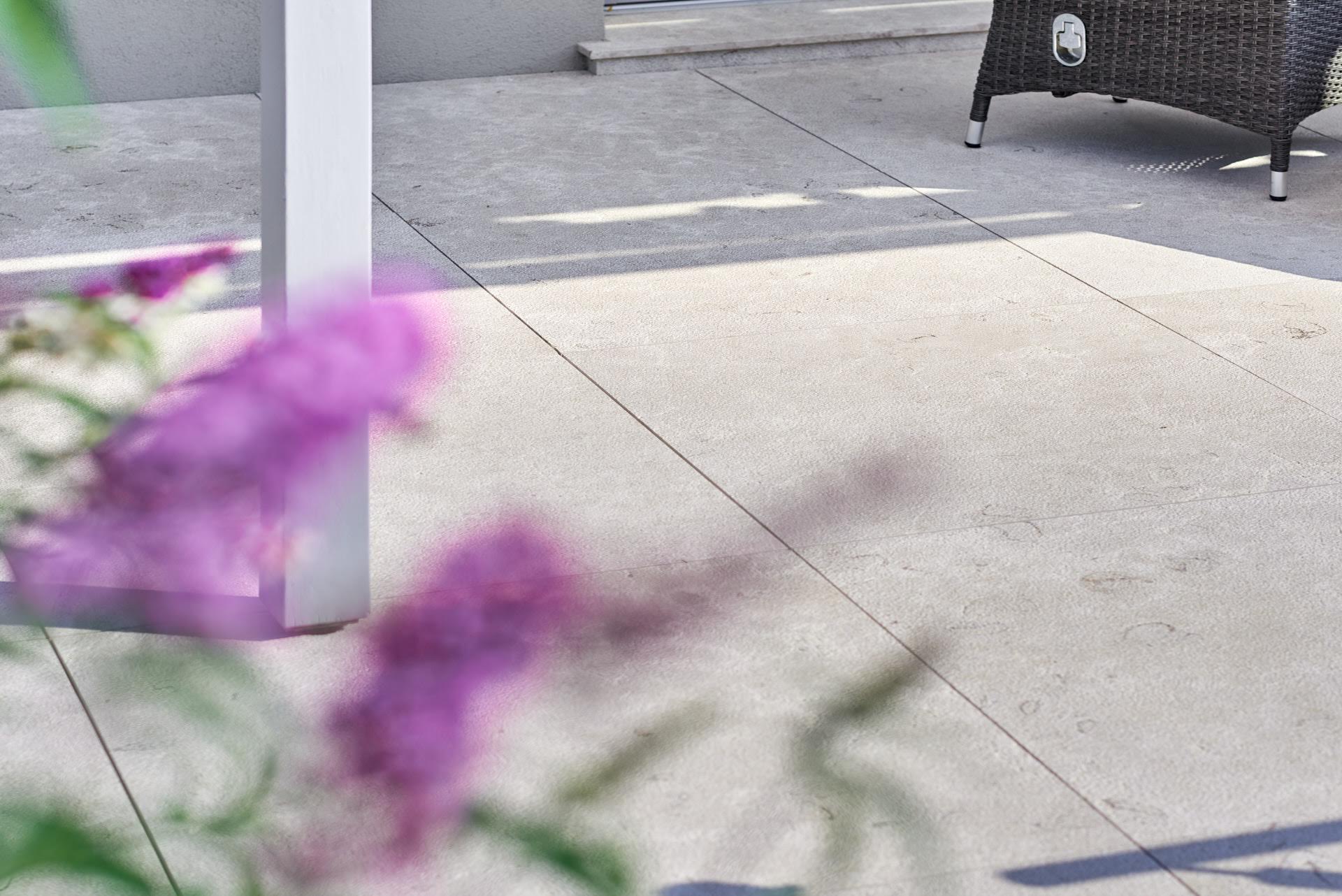Summer is finally here! The days are long, the evenings are balmy, pools and swimming pools beckon to cool off. A big trend this year is "vacation at home". People like to relax within their own four walls again and the importance of terraces and gardens has been growing, and not just since the coronavirus crisis. People are increasingly investing in their own gardens, as our experience from many consultations shows. Clients also want to enjoy the comforts they experience on vacation at home. Walking barefoot on a gently roughened stone surface warmed by the sun - does this also make you think of relaxing days in the south? With travertine or softly brushed limestone flooring, you can bring these vacation memories home forever. You can also create the marble bathroom that you enjoyed so much on vacation in your own apartment or house. Due to their high-quality appearance and pleasant feel, genuine natural stones are particularly popular not only on terraces and other outdoor areas, but also around swimming pools or swimming ponds.

Summer pleasures: the terrace and pool made of beige limestone flow seamlessly into the expansive landscape.
Photo: MW-Architekturfotografie
There are differences between building projects in the countryside and in the city, says stone4you sales manager Stanislav Ferencik: "While beige natural stones, especially limestones such as the dense Kanfanar and classic travertine, work well in all environments, clients in the city mainly opt for large-format slabs with edge lengths of 90 x 60, 80 x 80 or even 100 x 100 cm. With modern laying techniques and slab thicknesses of 3 cm, you are on the safe side when it comes to your new favorite places. Smaller formats or polygonal slabs are popular in rural surroundings. Stanislav Ferencik generally recommends adapting formats and laying patterns to the actual situation: "What looks nice on the internet is not automatically the best solution on site," says the natural stone professional from Hollabrunn. Careful advice is therefore always worthwhile.

Individually customized: Natural stone allows individual slab formats and slip-resistant surfaces for every project.
Photo: MW-Architekturfotografie
It's all about the water
One of the first questions about natural stone and swimming pools is water quality. In principle, all stones are suitable for fresh water containing chlorine. Travertine, limestone, sandstone and granite are popular for this purpose. When choosing a material for salt water, it is important to consider whether the salt water pool is covered with a movable dome. In this case, the stone4you stone professionals recommend granite or dense, de-icing salt-resistant limestone, for example Kirmenjak. The reason for this is condensation water, which condenses on the dome, runs down and collects as puddles on the ground. If less suitable varieties are used, the salts can cause damage to the surface of the stone. In the increasingly popular near-natural swimming ponds, care should be taken to keep the phosphorus content of the stone as low as possible to prevent green deposits on the natural stone. One tip for this is the dense Kanfanar limestone, which stone4you selects directly from the source in Istria.

Photo: MW-Architekturfotografie
High-quality stones from Europe
In addition to the easy-care and tried-and-tested limestone from Istria, the stone4you range includes numerous other natural stones from Central Europe. The core range mainly contains tried and tested stones from Austria and other nearby European countries. The aspect of sustainability is becoming increasingly important in the selection of materials. The origin of the raw material and the shortest possible transport route from extraction to the building site are becoming increasingly important. Stones from Austria best fulfill this requirement: Waldviertel granites such as the medium-grained Herschenberger are often used for steps, but Pannonia Grün - a harmoniously patterned slate from Burgenland - is also increasingly being used for indoor and outdoor projects.
How stones control heat
Flooring is like car paint: dark surfaces heat up more in the sunshine than light ones and every natural stone absorbs heat differently. The differences can amount to several degrees Celsius in midsummer. In addition to the aesthetic and technical properties, it is therefore becoming increasingly important to look at the thermal properties of a floor covering. For your next construction project, this means that a gray granite can no longer be walked on barefoot, depending on the location and intensity of the sunlight, while a light-colored limestone such as Kanfanar remains pleasantly cool even in midsummer.

Diverse exterior design: sunbathing area, steps, plant troughs and pool surrounds form a harmonious unit.
The surface finish has a major influence on the choice of natural stone. To ensure sufficient slip resistance, stone surfaces in outdoor areas are not polished, but have different roughnesses depending on their use and stress. In addition to the rough surfaces of slate and quartzite, the required surfaces are produced using mechanical processes. Travertine is often tumbled, limestone sandblasted and brushed. If particularly non-slip surfaces are required, the stones are bush-hammered and brushed. This makes the stones rough, but at the same time they remain pleasant to the touch.
Rougher surfaces are generally more slip-resistant, but also somewhat more difficult to clean. For the optimum balance between slip resistance and maintenance effort, careful advice from stone4you customer advisors based on sample slabs is always recommended. The color of the stone should match the ambience, the architectural style and, above all, the color of the house facade. Depending on this, there are natural stones for classic, Mediterranean and also functional-modern living and lifestyles. In the extensive showroom in Hollabrunn or in Vienna's Schottenring, you can experience the wide variety of natural stones, the individual play of colors and the subtle nuances of the natural building material up close.

Detail of a terrace with a bush-hammered surface. In the background, a herb garden with rough stones.
Photo: MW-Architekturfotografie
Formats and laying patterns characterize the surface
Once you have decided on your new favorite natural stone, it's time to choose the ideal slab format. The format has a direct influence on the laying pattern. Strips in widths of 40, 50 or 60 centimetres ensure a natural, staggered joint pattern. Fixed or alternating lengths are possible. Square formats are somewhat more complex, but these can also be individually adapted to the project. Classics such as the so-called Roman bond are also common and can be interpreted in a modern way, and the layout of the area to be covered often dictates which tile formats are best suited: For elongated surfaces, laying professionals tend to recommend strips, while square slabs show off the beauty of the natural material to its best advantage for square surfaces. Whichever format you choose: The basic requirement for any outdoor surface is the right gradient to prevent puddles or dangerous water films from forming. A slope of 2 percent is required to quickly drain rain or splash water from the surface - for example, in an outdoor shower or around the pool. This gradient must also be observed for stairs. A Rigol should also be planned for areas between the pool and the house. A sufficient slope is not only required for new buildings, but also for renovations. To ensure that the new floor covering is a lasting pleasure, the substrate must be perfectly prepared by specialists when replacing older coverings with natural stone. Construction defects and botched substructure work will otherwise lead to damage to the floor covering.
 Non-slip natural stone slabs are suitable for steps, but also as tread slabs.
Non-slip natural stone slabs are suitable for steps, but also as tread slabs.
Photo: MW-Architekturfotografie  Floor covering in strips with different tile widths made from the Austrian slate Pannonia Green.
Floor covering in strips with different tile widths made from the Austrian slate Pannonia Green.
Photo: Wilfried Varga
Leave nothing to chance
As with any construction project, you should also devote sufficient time and attention to the planning of outdoor installations in order to avoid damage later on. This is where it pays to consult a stone4you customer advisor, who will not only help you choose the right stones, but will also be on hand to answer any questions you may have about safe installation. As an owner-managed company with 30 employees, stone4you also offers technical planning and installation from a single source in addition to material advice. Installation is carried out from the top edge of the concrete in accordance with the latest technical standards, which include drainage mats and mortars and sealants matched to the respective natural stone.


